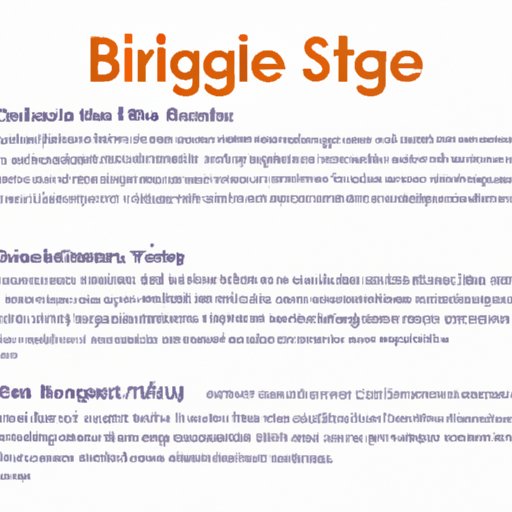Introduction
Writing bridges are an essential tool for connecting ideas and creating transitions in your written work. A bridge in writing is a sentence or phrase that links two separate ideas together. They can also be used to emphasize the importance of one idea over another, or to add emphasis to an argument. Writing bridges can help to make your writing clear, concise, and captivating.
A Comprehensive Guide to Writing Bridges
Writing bridges can be used to connect ideas within a single sentence, between sentences, or even between paragraphs. Here’s a comprehensive guide on how to use them effectively:
How to Use Bridges to Connect Ideas in Your Writing
When writing a bridge, you want to start by identifying the two ideas you want to link together. Once you’ve identified the two ideas, you can begin crafting your bridge. To create an effective bridge, you should consider the following:
- The purpose of your bridge: Is it to emphasize an idea? To introduce a new idea? To provide a contrast between two ideas?
- The tone of your bridge: Will it be formal or informal? Will it be lighthearted or serious?
- The structure of your bridge: Should it be a single sentence or multiple sentences? Should it include a rhetorical question?
Crafting Creative and Effective Writing Bridges
Once you’ve considered the purpose, tone, and structure of your bridge, it’s time to start crafting it. Here are some tips for crafting creative and effective writing bridges:
- Start with a strong transition word or phrase: Transition words and phrases can help to make your writing more fluid and help to emphasize the connection between two ideas. Examples of transition words and phrases include “in contrast,” “on the other hand,” “similarly,” and “nevertheless.”
- Provide a summary of the previous idea: Summarizing the previous idea can help to make your bridge more effective and will help to remind readers of the context. This can be done in a single sentence or with a few sentences.
- Introduce the new idea: After summarizing the previous idea, you can then introduce the new idea. This can be done in a single sentence or with a few sentences.
- Conclude with a strong statement: Finally, conclude your bridge with a strong statement. This will help to emphasize the connection between the two ideas and will leave readers with an impactful impression.
Examples of Writing Bridges Used in Literature
Now that you’re familiar with how to craft effective writing bridges, let’s take a look at some examples of writing bridges used in literature. These examples will help to illustrate the different types of writing bridges and how they can be used in your own writing.
Three Types of Bridges and How to Use Them in Writing
There are three main types of writing bridges: explicit bridges, implicit bridges, and rhetorical bridges. Explicit bridges are direct statements that explicitly state the relationship between two ideas. Implicit bridges use language to imply the relationship between two ideas. Rhetorical bridges use questions or statements to draw attention to a particular idea or to emphasize an argument.
Bridging the Gap: Writing Bridges for Smooth Transitions
Writing bridges can also be used to create smooth transitions in your writing. When transitioning from one idea to another, it’s important to provide a bridge that clearly states the connection between the two ideas. This will help to ensure that readers understand the context and follow the flow of your writing.
Harnessing the Power of Writing Bridges to Enhance Your Storytelling
Finally, writing bridges can be used to enhance your storytelling. By using bridges to emphasize key points, add tension, and create suspense, you can take your storytelling to the next level. Doing so will keep readers engaged and will help to create a captivating story.
Conclusion
Writing bridges are a powerful tool for connecting ideas and creating smooth transitions in your writing. They can be used to emphasize the importance of one idea over another, to add emphasis to an argument, and to enhance your storytelling. By following the tips outlined in this guide, you can craft effective writing bridges and use them to improve your writing.
With practice, you can learn to use writing bridges to capture your readers’ attention and engage them in your work.
(Note: Is this article not meeting your expectations? Do you have knowledge or insights to share? Unlock new opportunities and expand your reach by joining our authors team. Click Registration to join us and share your expertise with our readers.)
